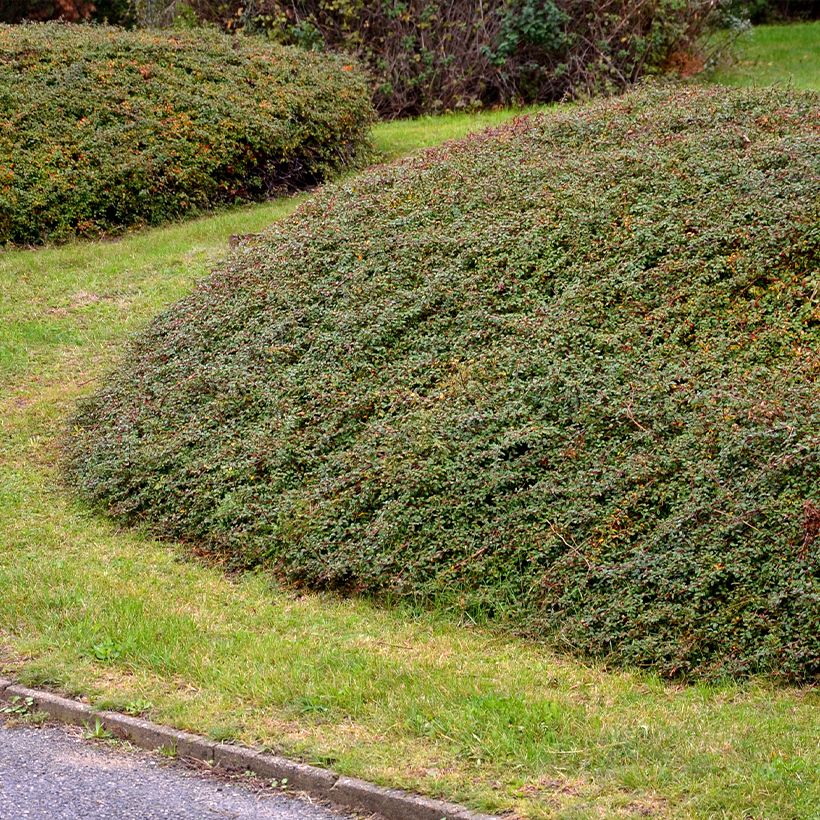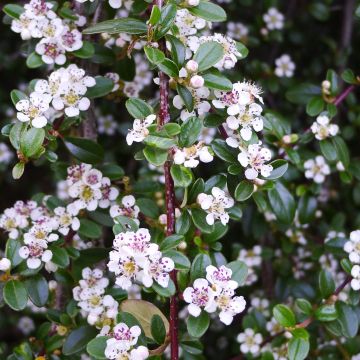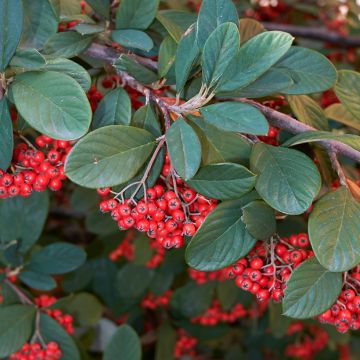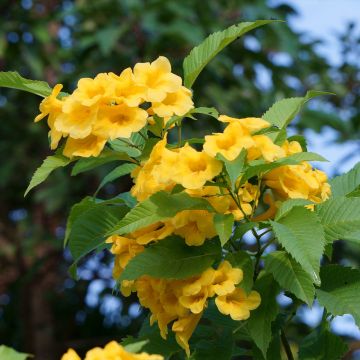

Cotoneaster divaricatus - Cotonéaster divariqué


Cotoneaster divaricatus - Cotonéaster divariqué


Cotoneaster divaricatus - Cotonéaster divariqué
Cotoneaster divaricatus
Cotoneaster divaricatus
Spreading Cotoneaster
Special offer!
Receive a €20 voucher for any order over €90 (excluding delivery costs, credit notes, and plastic-free options)!
1- Add your favorite plants to your cart.
2- Once you have reached €90, confirm your order (you can even choose the delivery date!).
3- As soon as your order is shipped, you will receive an email containing your voucher code, valid for 3 months (90 days).
Your voucher is unique and can only be used once, for any order with a minimum value of €20, excluding delivery costs.
Can be combined with other current offers, non-divisible and non-refundable.
Why not try an alternative variety in stock?
View all →This plant carries a 24 months recovery warranty
More information
We guarantee the quality of our plants for a full growing cycle, and will replace at our expense any plant that fails to recover under normal climatic and planting conditions.
Would this plant suit my garden?
Set up your Plantfit profile →
Description
Cotoneaster divaricatus, also known as spreading cotoneaster, is not the most well-known among bushes that are abundantly planted in landscaping. It is ornamental, useful for small fauna, and particularly robust. With an unusual habit, it develops a crown in the shape of a parasol over time that stands out in the garden. Its late spring flowers are nectar-rich and give way to dark red berries sought after by birds. Its deciduous foliage takes on very beautiful autumnal hues. Resistant to cold and dryness and interesting 9 months out of 12, this cotoneaster has all the qualities of an excellent hedge plant.
Costoneaster divaricatus is a bush from the Rosaceae family, just like its cousins the pyracanthas. It is native to western China and central China. This cotoneaster tolerates limestone and dry soils very well in summer. Its growth is moderately fast, it initially has sparse branches. With time, this bush forms a mass that is wider than it is tall, reaching an average height of 2.5 m (8 ft 2 in) and up to 5 m (16 ft 5 in) in width. Its habit is unusual, but interesting: the branches are initially erect, then they bend strongly to form a parasol-shaped crown in older subjects. The lateral branches spread gracefully in a fan shape. This cotoneaster blooms in May-June, in the form of very small nectar-rich flowers with pink-tinged white petals, grouped in 2 to 4. The flowers are followed by fruits, ripening in September-October. These are oval and cylindrical, shiny dark red berries, 1 cm (0.4 in) long, decorative and sought after by birds. The foliage of this bush is deciduous. It consists of small alternate, elliptical leaves, 1 to 2.5 cm (0.4 to 1 in) long, with a shiny dark green colour on the upper side, the underside light green and slightly downy. In autumn, they turn from dark orange to orange-brown.
Cotoneasters are highly appreciated by novice gardeners or those who don't have much time to devote to garden maintenance: they are accommodating, sturdy and decorative for a large part of the year. The Cotoneaster divaricatus can be used in shrub beds and as an informal hedge. It is a good border plant, for example in front of a grove of tall trees. Combine it with Berberis, viburnum, milky cotoneaster, Elaeagnus ebbingei, Photinias, and other cherry laurels in a large evergreen and windbreak hedge. It will provide shelter and cover for all the small fauna in the garden. It can also be an unusual specimen as a standalone plant, placed at the corner of a shrub bed or at the end of a pathway.
Cotoneaster divaricatus in pictures






Plant habit
Flowering
Foliage
Botanical data
Cotoneaster
divaricatus
Rosaceae
Spreading Cotoneaster
China
Other Cotoneaster
View all →Planting and care
Position the Cotoneaster divaricatus in the sun to promote abundant flowering. It can also be placed in a semi-shaded area. It only dislikes north-facing exposures. Plant it in ordinary soil (slightly acidic to chalky), well prepared and enriched with compost. You can plant it at any time of the year, except during freezing periods or extreme heat and drought. This cotoneaster tolerates heat and dry summers. It can be attacked by scale insects, aphids and caterpillars. Fire blight and rot are disease risks.
Planting period
Intended location
Care
Planting & care advice
This item has not been reviewed yet - be the first to leave a review about it.
Similar products
Haven't found what you were looking for?
Hardiness is the lowest winter temperature a plant can endure without suffering serious damage or even dying. However, hardiness is affected by location (a sheltered area, such as a patio), protection (winter cover) and soil type (hardiness is improved by well-drained soil).

Photo Sharing Terms & Conditions
In order to encourage gardeners to interact and share their experiences, Promesse de fleurs offers various media enabling content to be uploaded onto its Site - in particular via the ‘Photo sharing’ module.
The User agrees to refrain from:
- Posting any content that is illegal, prejudicial, insulting, racist, inciteful to hatred, revisionist, contrary to public decency, that infringes on privacy or on the privacy rights of third parties, in particular the publicity rights of persons and goods, intellectual property rights, or the right to privacy.
- Submitting content on behalf of a third party;
- Impersonate the identity of a third party and/or publish any personal information about a third party;
In general, the User undertakes to refrain from any unethical behaviour.
All Content (in particular text, comments, files, images, photos, videos, creative works, etc.), which may be subject to property or intellectual property rights, image or other private rights, shall remain the property of the User, subject to the limited rights granted by the terms of the licence granted by Promesse de fleurs as stated below. Users are at liberty to publish or not to publish such Content on the Site, notably via the ‘Photo Sharing’ facility, and accept that this Content shall be made public and freely accessible, notably on the Internet.
Users further acknowledge, undertake to have ,and guarantee that they hold all necessary rights and permissions to publish such material on the Site, in particular with regard to the legislation in force pertaining to any privacy, property, intellectual property, image, or contractual rights, or rights of any other nature. By publishing such Content on the Site, Users acknowledge accepting full liability as publishers of the Content within the meaning of the law, and grant Promesse de fleurs, free of charge, an inclusive, worldwide licence for the said Content for the entire duration of its publication, including all reproduction, representation, up/downloading, displaying, performing, transmission, and storage rights.
Users also grant permission for their name to be linked to the Content and accept that this link may not always be made available.
By engaging in posting material, Users consent to their Content becoming automatically accessible on the Internet, in particular on other sites and/or blogs and/or web pages of the Promesse de fleurs site, including in particular social pages and the Promesse de fleurs catalogue.
Users may secure the removal of entrusted content free of charge by issuing a simple request via our contact form.
The flowering period indicated on our website applies to countries and regions located in USDA zone 8 (France, the United Kingdom, Ireland, the Netherlands, etc.)
It will vary according to where you live:
- In zones 9 to 10 (Italy, Spain, Greece, etc.), flowering will occur about 2 to 4 weeks earlier.
- In zones 6 to 7 (Germany, Poland, Slovenia, and lower mountainous regions), flowering will be delayed by 2 to 3 weeks.
- In zone 5 (Central Europe, Scandinavia), blooming will be delayed by 3 to 5 weeks.
In temperate climates, pruning of spring-flowering shrubs (forsythia, spireas, etc.) should be done just after flowering.
Pruning of summer-flowering shrubs (Indian Lilac, Perovskia, etc.) can be done in winter or spring.
In cold regions as well as with frost-sensitive plants, avoid pruning too early when severe frosts may still occur.
The planting period indicated on our website applies to countries and regions located in USDA zone 8 (France, United Kingdom, Ireland, Netherlands).
It will vary according to where you live:
- In Mediterranean zones (Marseille, Madrid, Milan, etc.), autumn and winter are the best planting periods.
- In continental zones (Strasbourg, Munich, Vienna, etc.), delay planting by 2 to 3 weeks in spring and bring it forward by 2 to 4 weeks in autumn.
- In mountainous regions (the Alps, Pyrenees, Carpathians, etc.), it is best to plant in late spring (May-June) or late summer (August-September).
The harvesting period indicated on our website applies to countries and regions in USDA zone 8 (France, England, Ireland, the Netherlands).
In colder areas (Scandinavia, Poland, Austria...) fruit and vegetable harvests are likely to be delayed by 3-4 weeks.
In warmer areas (Italy, Spain, Greece, etc.), harvesting will probably take place earlier, depending on weather conditions.
The sowing periods indicated on our website apply to countries and regions within USDA Zone 8 (France, UK, Ireland, Netherlands).
In colder areas (Scandinavia, Poland, Austria...), delay any outdoor sowing by 3-4 weeks, or sow under glass.
In warmer climes (Italy, Spain, Greece, etc.), bring outdoor sowing forward by a few weeks.





























































